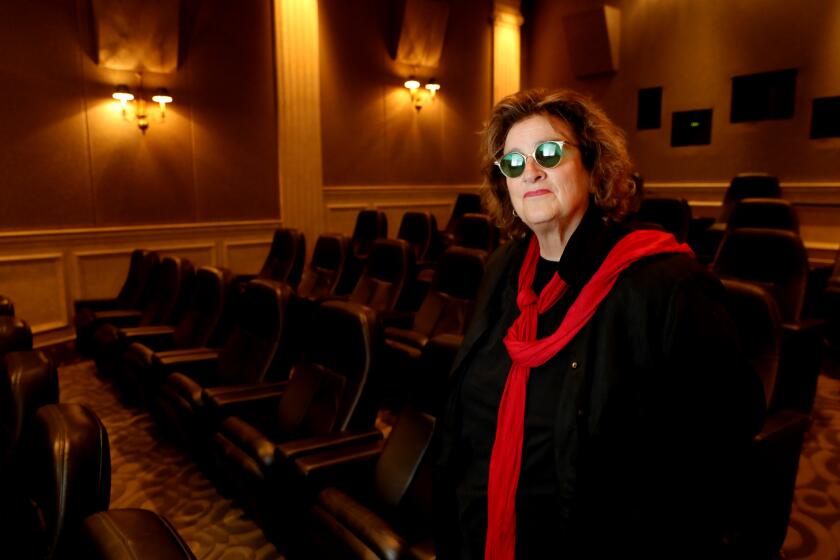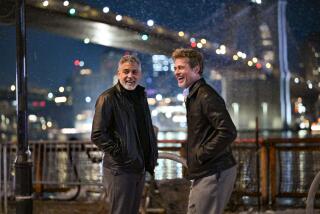Once upon a time, Tarantino slept in his car and DiCaprio was a break dancer
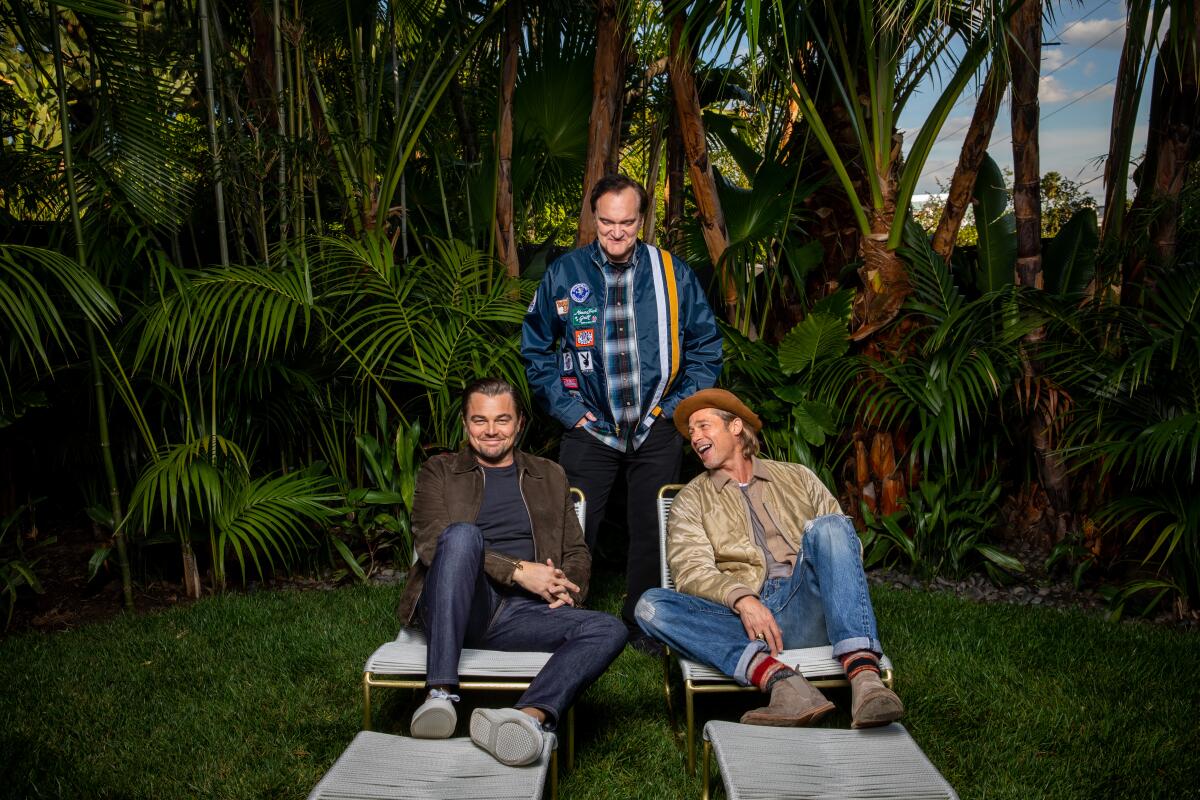
“I swear to God, I had to hide a tear,” Brad Pitt says, looking over at Quentin Tarantino and Leonardo DiCaprio, remembering the first time Tarantino played him the José Feliciano cover of “California Dreamin’” on the set of “Once Upon a Time ... in Hollywood.” “Look,” Pitt continues. “I’m not ashamed to say it. I got a little misty.”
We’ve settled onto a couple of sofas inside a bungalow at the Chateau Marmont because ... where else would we meet to talk about Tarantino’s wistful elegy to a bygone Hollywood? As the song declares, it’s a winter’s day, though the (palm tree) leaves are green, not brown, and the sun setting just beyond the swimming pool is making the sky periwinkle blue, not a dismal gray.
But otherwise, yeah, we’re California dreamin’, sitting back, talking about a movie that earned 10 Oscar nominations — three for Tarantino as a director, writer and producer, and acting nods for DiCaprio and Pitt — and also considering the good fortune that has graced their lives over the last few decades.
“You know, when I first moved out here, it was the summer of ’86 and I didn’t know [expletive]-all about Los Angeles, other than what I’d seen on ‘The Beverly Hillbillies’ and ‘Dragnet,’” Pitt says. “I landed in Burbank at a house I could crash at for a month or so. It was just me and a maid from Thailand who couldn’t speak English. Man, I was just so up for the adventure, and so excited when I’d drive by a studio where they make movies. It meant the world to me.”
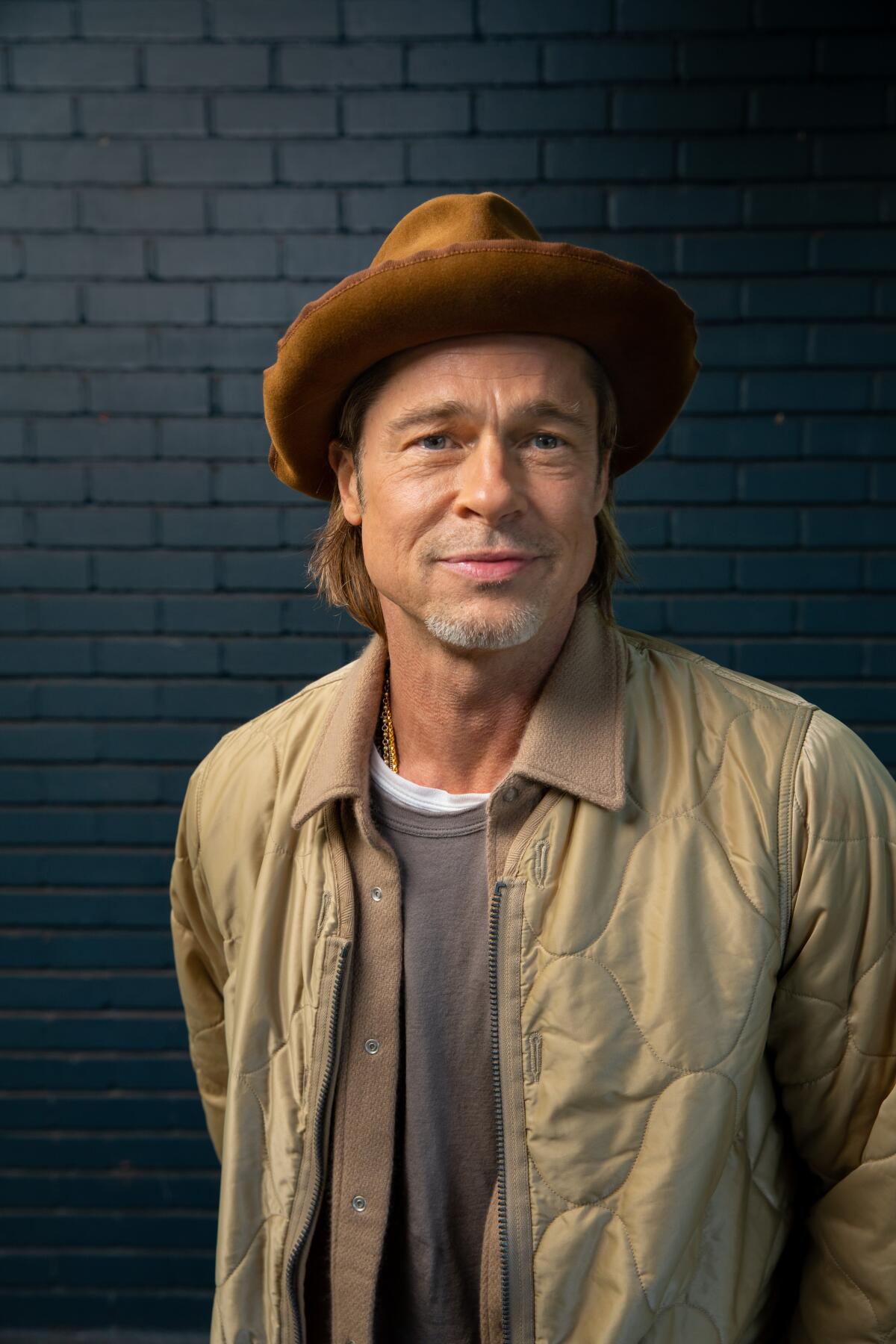
“Then I moved and it was one of those eight guys in a two-bedroom apartment in North Hollywood kind of things,” Pitt continues, smiling at the memory. “You have your little corner where you keep your clothes folded up in a little bedroll. I became quite accustomed to McDonald’s and Shakey’s Pizza buffet. I didn’t mind. The city was a wide-open experience.”
Pitt presses Tarantino to tell tales of living in his car, writing scripts. “Which part of town?” he asks. Tarantino evades the queries for a bit, then relents. “It was at the back of Video Archives,” Tarantino says, talking about the Manhattan Beach video store where he worked in the ‘80s, turning customers on to kung fu and blaxploitation movies while writing “Reservoir Dogs.” And, yes, he slept in his car, a Ford Capri, around back in the parking lot.
“You’re not stretching out in a Ford Capri, are you?” Pitt asks, laughing.
DiCaprio’s parents moved to L.A. at the behest of his mom, who spied a Venice Beach postcard while living in the Bronx and thought, “This is where I want to move.” They settled east of Hollywood. Tarantino can picture the precise location because the apartment was right by the pool hall where Martin Scorsese shot the interiors for his 1973 drama “Mean Streets.”
“Hollywood and Western,” DiCaprio says, pinpointing the cross streets. “Then we moved to Silver Lake and it was me bugging my parents on the commute to go to school on the Westside to please, please, please drop me off at auditions. But I kept getting rejected by agents. I think because I was a break dancer at the time and had crazy haircuts ...”
Pitt interrupts with a burst of laughter. “You were a break dancer? There’s got to be video somewhere.” DiCaprio cops to owning a little footage. “Oh, my God,” Pitt says. “VHS of course. I’ve got to see it. We need a movie night.”
“But that rejection,” DiCaprio continues, “it was like, even though I lived in the mecca of this dream land that was the movie industry, it felt like this intangible world where I needed a fairy godmother to come down and say, ‘You are anointed as an actor.’”
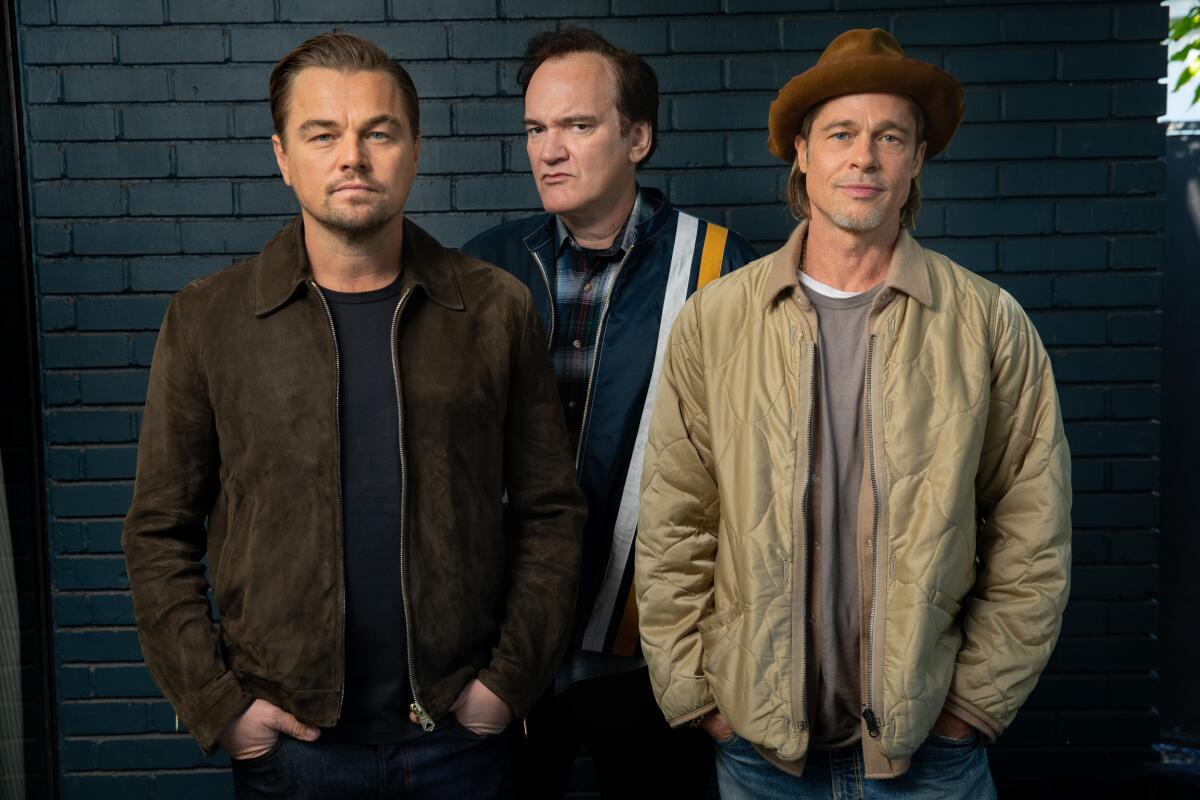
“Once Upon a Time ... in Hollywood” considers the idea of which actors become blessed and the others who remain on the periphery, as well as the insecurities inherent in the profession and the value in simply being a working actor making a living. It’s a couple of days in the lives of a fading TV western star named Rick Dalton (DiCaprio) trying to forge a career in a changing Hollywood and his loyal, longtime stunt double, Cliff Booth (Pitt), a good friend and possible scoundrel who, rumor has it, killed his wife. There’s no plot, just the dark shadow of history lurking around the edges. Rick lives in Benedict Canyon on Cielo Drive. Roman Polanski and his wife, Sharon Tate, are renting the house next door.
Pitt and particularly DiCaprio were single-minded in their determination to make a go of it as actors. They succeeded, but they know it could easily have turned out differently. Tarantino loves to pepper Pitt with questions about his early acting career, a drill that seems both a quest for knowledge and an exercise that he knows will end only in frustration.
“I want him to be more excited about it than he is because I get excited by it,” Tarantino says, warming up. “Like, I think it would have been [expletive] awesome in the ‘60s to guest on ‘The Man from U.N.C.L.E.’ and do a scene with David McCallum as Illya Kuryakin. That would have been cool. It would have been [expletive] awesome to do a ‘Baretta’ with Robert Blake. Or a ‘Kung Fu’ with David Carradine.
“And Brad did things like that. ‘You did a “Dallas”? Did you do a scene with J.R.?’ ‘I don’t remember.’ ‘YOU DON’T REMEMBER IF YOU HAD A SCENE WITH J.R.?!?’” Pitt, seated next to Tarantino, wearing a parka because he’s feeling “toxic,” nearly lands on the floor, laughing. “‘I did a “21 Jump Street.” ’Oh. Did you and Depp have a scene together?’ ‘I don’t remember.’ ‘YOU DO NOT REMEMBER IF YOU HAD A [EXPLETIVE] SCENE WITH JOHNNY DEPP ON “21 JUMP STREET”?’ He’s just being cool. ‘Yeah, whatever. I don’t remember any of that [expletive].’”
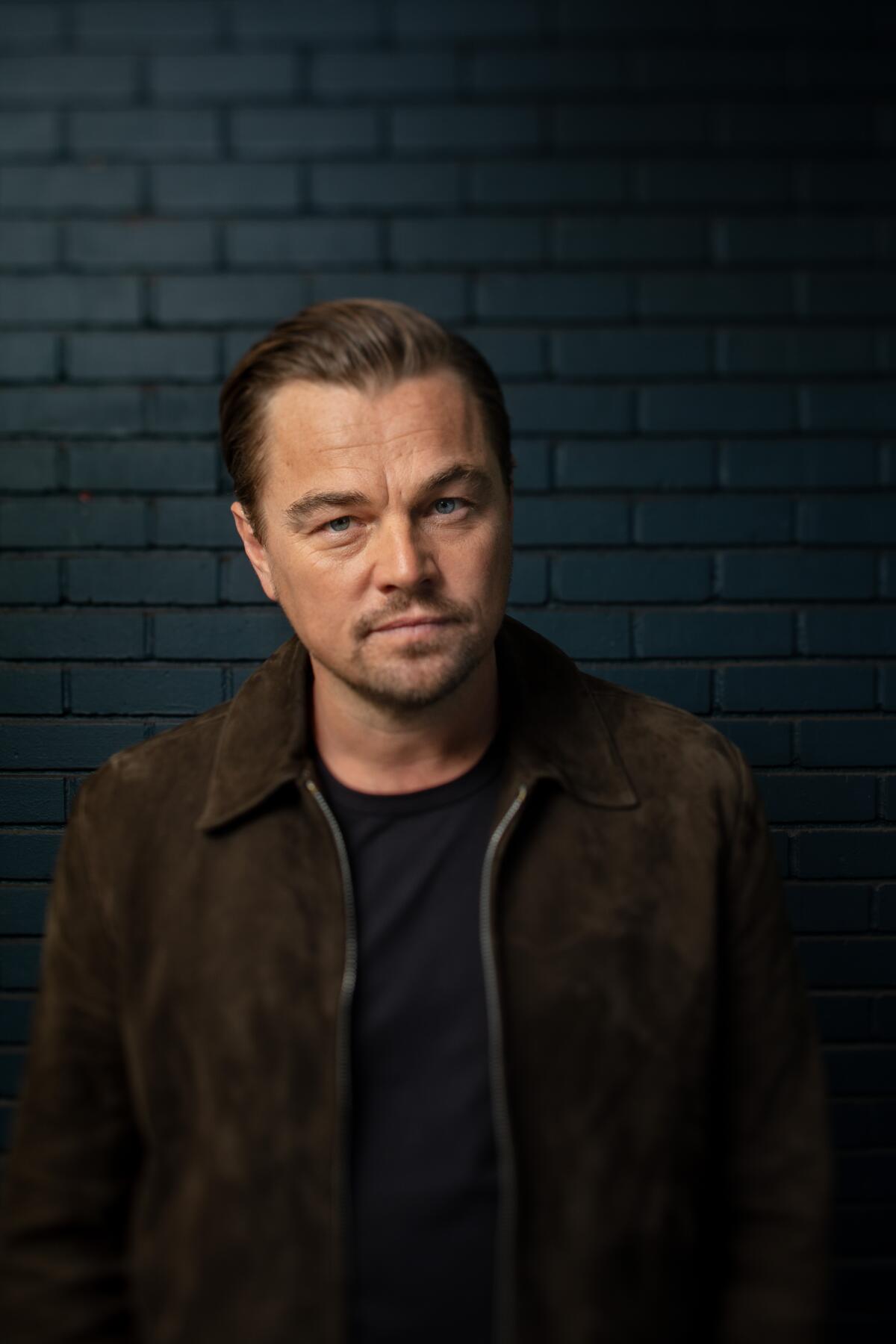
“It’s not that bad,” Pitt offers in his defense. “I was on three episodes of ‘Dallas’ and I think I had one line. And it was either ‘yes’ or ‘no.’ And that I cannot remember.” Tarantino adds that Pitt played Charlene Tilton’s boyfriend. Apparently he was the strong silent type.
The conversation circles back around to “California Dreamin’,” Feliciano’s haunting cover of the Mamas and the Papas song heard in “Once Upon a Time ... in Hollywood” as Rick and Cliff drive home after a rather eventful day. Rick has gone through hell and back, shooting a guest spot on a TV pilot called “Lancer,” first trashing his trailer in a rage fueled by self-pity, doubt and a haze of whiskey sours and then recovering to later nail his big scene. Cliff has picked up a hippie hitchhiker, dropped her off at Spahn Ranch and then engaged in a showdown with Manson family members on the western town movie set.
“They both had these pretty insane days, and then we get in the car and I remember asking Quentin, ‘Should we talk about this?’” DiCaprio says. “And Quentin was like, ‘Just get in the car and drive.’ And it’s like this palate cleanser. And it’s also sincerely who these two guys were. We’re going home, get a pizza, drink some beer and watch me on ‘The FBI.’ That’s our therapy. And I have that relationship with some of my friends. ‘Let’s just sit and say nothing.’”
Pitt nods. “And then maybe three days later, Cliff would tell him what happened. Or he probably didn’t tell Rick because he’d get pissed off that he’d have to spend the 18 bucks to fix the flat tire. ‘What the [expletive] were you driving to Chatsworth for? Why is the mileage in my car so off?’”
Of all the lines in all the reviews written about “Once Upon a Time ... in Hollywood,” the one that Tarantino cherishes relates to the film’s verisimilitude in re-creating a Los Angeles with half a century in its rear-view mirror.
Here’s where to find the Los Angeles attractions saluted in Quentin Tarantino’s new “Once Upon a Time ... in Hollywood,” from Musso & Frank’s to Spahn Ranch.
“It was, ‘When Cliff drives through L.A. it was like Brad Pitt driving through a documentary,’” Tarantino remembers, laughing. “And, frankly, if you do a movie like this, that’s the thing you want to nail and really be proud of that. It’s like [Werner] Herzog. ‘Yeah, we really nailed the Amazon in ‘Fitzcarraldo.’ Well, we nailed Los Angeles.”
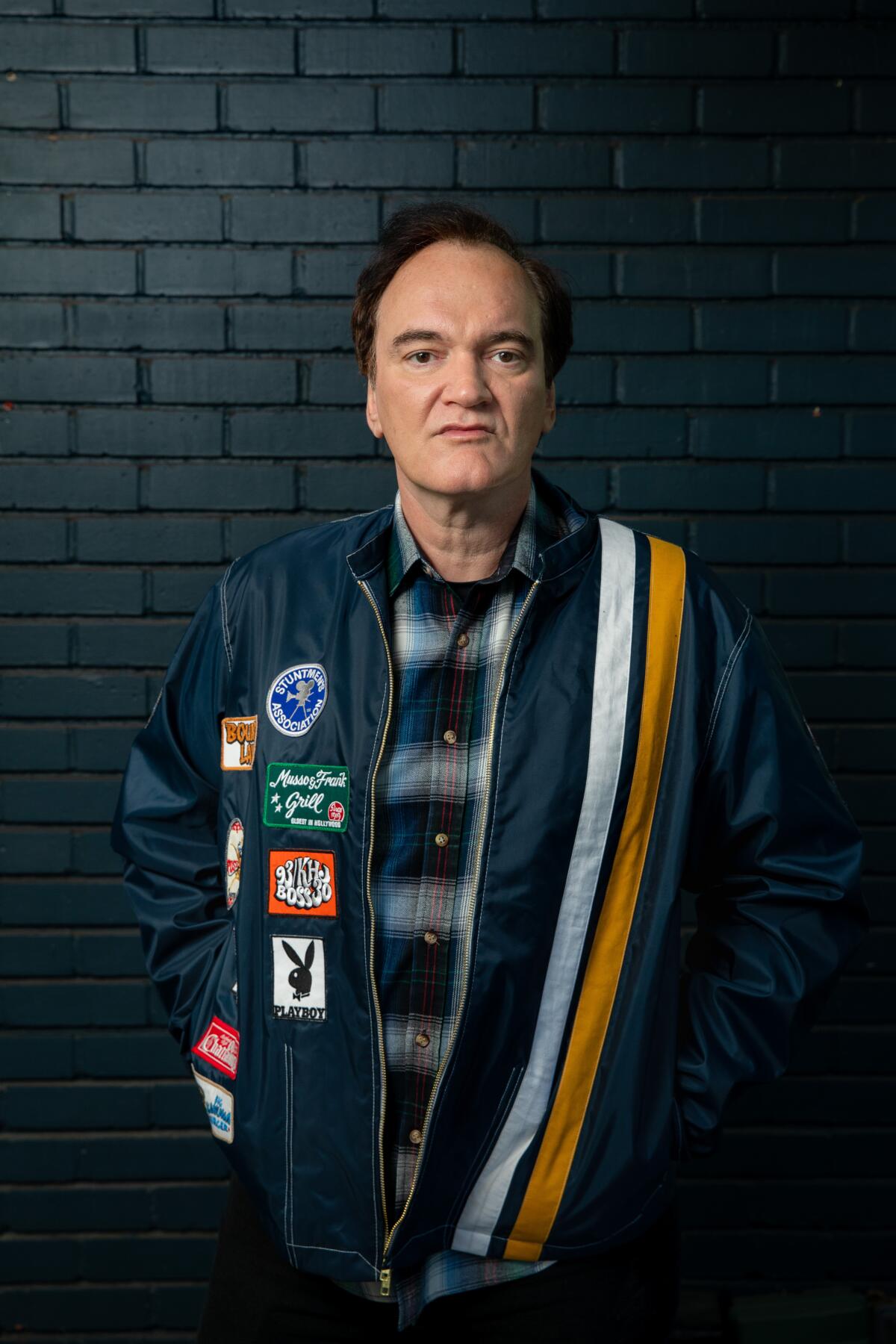
DiCaprio loves this comparison so deeply that he will repeat “we really nailed the Amazon” half a dozen times before we leave. It also triggers an idea, a sort of side hustle that he seems willing to bankroll.
“Do a ‘Once Upon a Time ... in Hollywood’ tour and take on the TMZ buses that show up at our houses,” DiCaprio says. “We could make a lot of moolah and put them out of business.” Tarantino starts ticking off the possible locales — Westwood Village, Musso & Frank Grill, the landmark Mexican restaurants El Coyote and Casa Vega — noting that he recently went on a Vienna walking tour of spots used in Carol Reed’s 1949 film noir “The Third Man” and loved it. “Except for the rats in the sewers,” he adds. “They freaked me out.”
Quentin Tarantino’s “Once Upon a Time ... in Hollywood” draws on personal memories for its look at an L.A. gone by, says production designer Barbara Ling.
“But it needs to be done sooner than later,” DiCaprio adds. “There’s such a disposability to this town. We create this permanence in these movies and they get burned into celluloid and that’s what we live with. Everything else just evaporates and disappears. Los Angeles is constantly evolving and changing. That’s why movies like this are so engaging.”
At some point, unnoticed, Pitt has wrapped a knit scarf around his neck, though it’s not so much a scarf as a throw blanket. The sun has disappeared and it’s time to leave, embarking on journeys along Hollywood streets that can no longer be navigated with the ease that Cliff Booth employed in his Karmann Ghia.
“We’re all just passing through, doing the best we can in these movies,” Pitt says, offering an elbow bump as a departure greeting. “But this one, I would say it’s one of the few times where the experience is as special and unique as the final film. Like our life is as important as the final product. For me, that’s, ‘We’re livin.’”
More to Read
Only good movies
Get the Indie Focus newsletter, Mark Olsen's weekly guide to the world of cinema.
You may occasionally receive promotional content from the Los Angeles Times.
